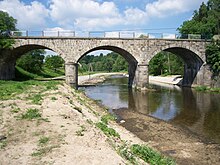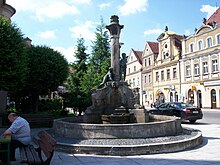Gryfów Śląski
| Gryfów Śląski | ||
|---|---|---|

|
|
|
| Basic data | ||
| State : | Poland | |
| Voivodeship : | Lower Silesia | |
| Powiat : | Lwówek Śląski | |
| Area : | 6.63 km² | |
| Geographic location : | 51 ° 2 ' N , 15 ° 25' E | |
| Height : | 325 m npm | |
| Residents : | 6636 (Jun. 30, 2019) |
|
| Postal code : | 59-620 | |
| Telephone code : | (+48) 75 | |
| License plate : | DLW | |
| Economy and Transport | ||
| Street : | Jelenia Góra - Zgorzelec | |
| Next international airport : | Wroclaw | |
| Gmina | ||
| Gminatype: | Urban and rural municipality | |
| Gmina structure: | 7 school offices | |
| Surface: | 66.61 km² | |
| Residents: | 9697 (Jun. 30, 2019) |
|
| Population density : | 146 inhabitants / km² | |
| Community number ( GUS ): | 0212013 | |
| Administration (as of 2012) | ||
| Mayor : | Olgierd Poniźnik | |
| Address: | Rynek 1 59-620 Gryfów Śląski |
|
| Website : | www.gryfow.pl | |
Gryfów Śląski (German Greiffenberg ) is a town in the powiat Lwówecki in the Polish Voivodeship of Lower Silesia .
Geographical location
Gryfów Śląski is located in the southwest of the Lower Silesian Voivodeship in the historical region of Lower Silesia on the border with Upper Lusatia . The voivodeship capital Wroclaw is located approx. 170 km east of Gryfów Śląski. The district town of Lwówek Śląski is about 18 km to the north-west. The state road Droga krajowa 30 and the voivodship road Droga wojewódzka 360 run through Gryfów Śląski .
Gryfów Śląski is located on the right bank of the Queis above the Goldentraum dam .
history
middle Ages

The city Greiffenberg the Duchy of Jawor probably originated during the reign of Duke Bolko I of Świdnica and Jawor in the forest area between Bohemia , the Silesian Bobergau and the Lusatian Gau Zagost . A city privilege to Löwenberg law was granted in 1354, in 1405 the city got the right to build walls. The history of the origins of a city castle on the city wall is not known. It was first ducal in 1418, together with the Greiffenstein Castle and the town of Friedeberg, two kilometers to the south, as a gift from the Bohemian King Wenceslaus to his councilor Jan von Chotěmice . In the same year he sold the estate to the knight Gotsche II. Schoff , Lord of Kynast , whose descendants (who henceforth wrote themselves in his honor "Schoff, called Gotsch") held it until 1945.
The names of the Greiffenstein Castle on the border with Lusatia or the border town of Greiffenberg could come from an attack by an enemy. The chronicle writer Knie reports in a geographical description of Silesia from 1832 based on an old legend that a nest with young griffins was found during the construction of the castle and that is why the castle was called "Greiffenstein". This legend is reflected in the coat of arms, which shows a fairytale bird - half eagle, half lion - with a knight in armor in its claws. The one from Greiffenstein represents the same, legendary "bird" with a stone in its claws and is included in the coat of arms of the barons and later counts Schaffgotsch .
Early modern age
The 15th century brought a whole series of catastrophes: huge storms with floods, epidemics that carried away the inhabitants and devastated the surrounding villages, droughts and fires throughout the city. The Hussite Wars , which lasted intermittently from 1427 to 1431 , caused much damage. Despite these adversities, the city's bourgeoisie managed to rebuild the brick church and rectory in 1512 . In 1524 a magnificent town hall was built. In 1542 the bell tower of the church was raised. In 1544 Hans Schaffgotsch had a mill with six mill wheels built on Queis and behind the Hirschberger Tor he built a hospital with his brother Christoph. A unique epitaph of the Schaffgotsch family dates from this time . It commemorates the family's misfortune in the years 1584–1589 when Hans Schaffgotsch and his wife Magdalena v. Zedlitz died a little later, her son Hans Ulrich, daughter Magdalena and, in 1601, her husband Christoph. The work carved in sandstone with portraits of the deceased in natural size is one of the few such works that were created in the Renaissance style . The Schaffgotsch Chapel also houses the graves of Christoph's second wife, Eleonore v. Promnitz, married in second marriage to Count Johann Georg von Hohenzollern, and his daughter-in-law Barbara Agnes Schaffgotsch, who died in 1631, daughter of Duke Joachim Friedrich von Liegnitz and Brieg and wife of the unfortunate General Hans Ulrich. During the Thirty Years' War the Swedes stormed the Greiffenstein in 1645, which they had besieged five years earlier in vain.
Industrialization under Prussian rule
In the middle of the 17th century there were already 26 department stores in Greiffenberg, which operated shops in Germany and abroad. The emergence of the manufactories had transformed the small home productions into more organized forms. The factories had started producing linen damask and other fabrics. The economic situation began to stabilize when a dangerous fire broke out in 1783. The fire destroyed the brewery, malt house, the parish building and 120 town houses. Only the houses on Rzeczna Street and on the southern and western sides of the market square were spared. The city survived this catastrophe. The Napoleonic Wars did not cause any major damage. An important industrial center and most important company became the Greiff-Werke , in whose textile factories a total of 7,000 people worked.
In 1865 Greiffenberg received a station on the Silesian Mountain Railway from Görlitz to Hirschberg . Branch lines later led to Löwenberg , Bad Flinsberg and across the nearby border into the Bohemian Friedland .
The then most modern factory of the Siemens company was opened in 1927 and taken over by ITT Industries in 1996 . During the hyperinflation from 1919 to 1923, the Stadtsparkasse issued its own city banknotes and coins. After the fire in the town hall tower in 1929, the tower was rebuilt in a modern form. The reinforced concrete structure used in the construction and preserved to this day was one of the first of its type in Lower Silesia.
Until 1945 Greiffenberg belonged to the district of Löwenberg in Silesia in the administrative district of Liegnitz in the Prussian province of Lower Silesia of the German Empire .
Gryfów Śląski as part of Poland
After the end of the Second World War , Greiffenberg and almost all of Silesia were placed under Polish administration by the Soviet occupying forces in the summer of 1945 . For Greiffenberg, the Poles introduced the place name Gryfów Śląski ("Silesian Greiffenberg"). The native German population was almost completely expelled from Greiffenberg by the local Polish administrative authority and Poles were settled from other parts of the country.
In 1996, the historical colors blue and yellow of Upper Lusatia were set for the municipal coat of arms and the flag , the eastern border of which is the Queis .
Population development
| year | Residents | Remarks |
|---|---|---|
| 1890 | 3,460 | 2,740 Protestants and 716 Catholics |
| 1933 | 4.113 | |
| 1939 | 4,344 |
Attractions

St. Hedwig
The St. Hedwig's Church (Pol. Kościół św. Jadwigi ) is a Roman Catholic church. It is located north of the ring on Koscielny Square (Polish plac Kocielny ). The church was built at the beginning of the 15th century. The main altar dates from 1606. Inside the church is the grave of the von Schaffgotsch family.
town hall
A first town hall was built around 1276. In 1524 a first stone town hall was built in the middle of the ring. After several fires, this was always rebuilt. The current building was built in the classicism style in a rectangular shape and has a mansard roof. In 1929 the tower helmet burned down. During the reconstruction, the town hall received a tower in a reinforced concrete structure, which up to then was first used in Silesia.
More Attractions
- Ring with town houses from the 17th, 18th and 19th centuries
- Ring fountain from 1908
- Remains of the medieval city fortifications
- historical bridge over the Queis
- Memorial to the fallen soldiers from 1813
local community
The urban and rural municipality Gryfów Śląski consists of the main town Gryfów Śląski as well as the following districts:
- Krzewie Wielkie ( Large Floor )
- Młyńsko ( Mill Seiffen )
- Proszówka ( Counts Neundorf )
- Rząsiny ( Welkersdorf )
- Ubocze ( Schosdorf )
- Wieża ( Wiesa )
- Wolbromów ( Klein-Neundorf )
Personalities
sons and daughters of the town
- Hans Ulrich von Schaffgotsch (1595–1635), General
- Joachim Nerger (around 1626–1682), German legal scholar
- Johann Hoffmann (17th century), teacher and Evangelical Lutheran hymn poet
- Johann Christoph Tschanter (1683–1738), Protestant Lutheran pastor and writer
- Hermann Steudner (1832–1863), German botanist and Africa explorer
- Georg Richard Kruse (1856–1944), German conductor, music researcher and author
- Curt Joël (1865–1945), German lawyer, civil servant and politician
- Johannes Maximilian Avenarius (1887–1954), German painter
- Walter Volland (1898–1980), German sculptor and art educator
- Alice Schmidt (1916–1983), German writer
- Andrzej Chyra (born 1964), Polish actor
Other personalities associated with the city
- Arno Schmidt (1914–1979), German writer, has been with the GREIFF works in Greiffenberg since 1934 ; Living there from 1938 until he was drafted into World War II.
literature
- Johannes Gotthelf Luge: Chronicle of the city of Greffenberg in Silesia . Greifenberg 1861 ( full text ).
- Hermann Teichgräber, Elisabeth Zimmermann: Greiffenberg linen merchants in four centuries. Görlitz 1938.
Web links
Individual evidence
- ↑ a b population. Size and Structure by Territorial Division. As of June 30, 2019. Główny Urząd Statystyczny (GUS) (PDF files; 0.99 MiB), accessed December 24, 2019 .
- ↑ a b Hugo Weczerka (Ed.): Handbook of historical sites . Volume: Silesia (= Kröner's pocket edition . Volume 316). 2nd, improved and enlarged edition. Kröner, Stuttgart 2003, ISBN 3-520-31602-1 , p. 148.
- ^ A b c Michael Rademacher: German administrative history from the unification of the empire in 1871 to the reunification in 1990. loewenberg.html # ew39lwbggreiff. (Online material for the dissertation, Osnabrück 2006).
- ^ History of the town hall







